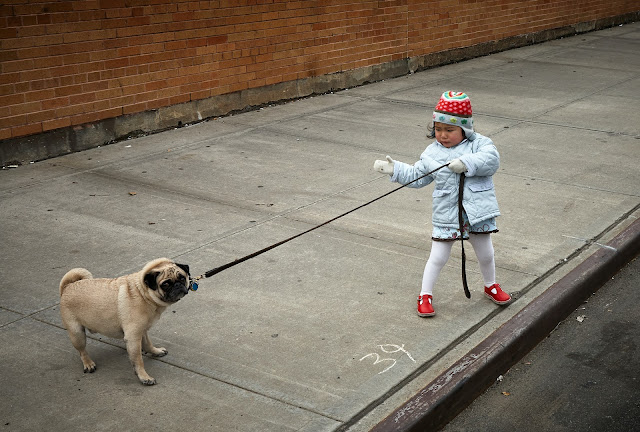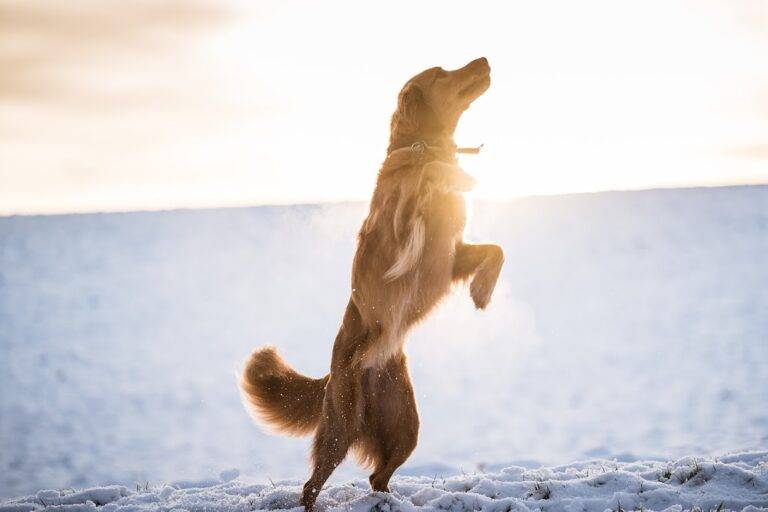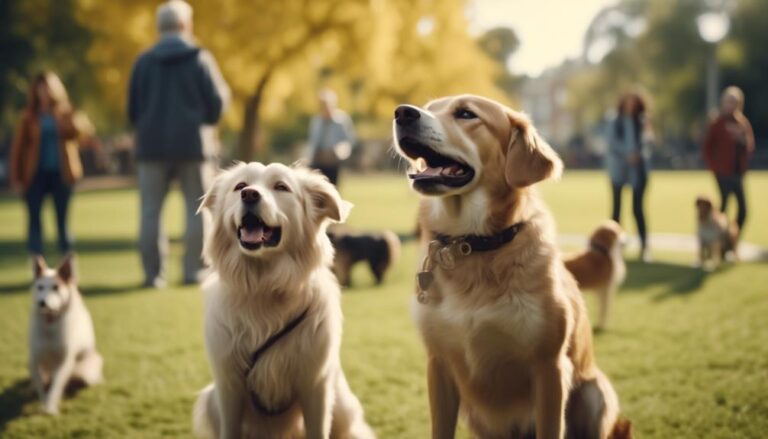How Do I Get My Dog To Stop Pulling On The Leash

How Do I Get My Dog To Stop Pulling On The Leash: Imagine walking down the street, your dog eagerly tugging at the leash like a determined sled dog, making the walk feel more like a sled ride. Frustrating, isn’t it? Well, fear not, for there are effective ways to put an end to this pulling madness and restore harmony to your walks. In this discussion, we will explore practical techniques and strategies that will help you guide your furry friend toward becoming a leash-walking superstar. So, if you’re ready to discover the secrets to achieving a peaceful stroll with your canine companion, let’s dive in and unleash the power of loose leash walking.
Invest in Proper Leash Equipment
Invest in the proper leash equipment to ensure a comfortable and secure walking experience for both you and your dog. Choosing the right leash is essential in preventing pulling during walks. Opt for a leash that is 6-10 inches long, allowing you to maintain control while giving your dog enough freedom to move. It’s important that the leash feels comfortable in your hand, so consider one with a padded handle or made from a soft material.
For unstructured exploration, such as in a park or open field, using a long line between 15-50 inches is recommended. This longer leash allows your dog to roam a bit more while still keeping them safe and connected to you. However, it’s crucial to avoid retractable leashes, as they can cause friction burns and are more difficult to control.
When it comes to the collar, opt for a plain, flat one that fits snugly around your dog’s neck. It should be tight enough to prevent slipping off but loose enough to comfortably fit two to four fingers between the collar and your dog’s neck. Alternatively, you can consider using an H-style or Y-style harness that has multiple leash attachment points. These types of harnesses distribute the pulling force more evenly, reducing strain on your dog’s neck and giving you more control.
Investing in proper leash equipment is an essential part of training your dog to stop pulling during walks. By choosing the right leash and collar or harness, you can ensure a comfortable and secure walking experience for both you and your furry friend.
Utilize Your Own Movement
Now that you have equipped yourself with the proper leash and collar or harness, it’s time to focus on utilizing your own movement to stop your dog from pulling on the leash. Teaching your dog to walk on a loose leash is an essential part of dog training. Many dogs naturally pull on the leash because they are excited or want to explore their surroundings. However, it’s important to teach them that pulling is not acceptable behavior.
To encourage your dog to walk on a loose leash, you can use your own movement to communicate with them. Start by walking in a straight line and whenever your dog starts to pull, immediately stop in your tracks. This sends a clear signal to your dog that pulling will not get them where they want to go. Once your dog stops pulling and the leash becomes loose, continue walking. Repeat this process every time your dog pulls, and they will gradually learn that pulling on the leash does not get them closer to their desired destination.
Another effective technique is to change direction whenever your dog starts to pull. Simply turn around and walk in the opposite direction. This not only stops your dog’s pulling behavior but also teaches them to pay attention to your movements. By changing direction frequently, your dog learns to focus on you and follow your lead.
Remember to reward your dog for walking on a loose leash. Use treats to encourage them to stay by your side and reward them when they do so. Positive reinforcement is a powerful tool for teaching your dog new behaviors, and treats can be a great motivator.
Pre-Walk Exercise for Your Dog
Before taking your dog for a walk, it’s important to engage in pre-walk exercises to warm up their muscles and get them mentally stimulated. Warm-up activities can include short bursts of jogging or playing fetch to get their blood flowing and loosen their muscles. Mental stimulation exercises, such as puzzle toys or training sessions, can help tire them out mentally and make the walk more enjoyable for both of you.
Warm-Up Activities
To prepare your dog for the walk, engage in mental and physical stimulation activities such as play sessions or sniffing opportunities. These warm-up activities are important because they help tire out your dog and provide the necessary mental and physical stimulation before leash training. Incorporate vigorous exercise like fetch or stair climbing to help burn off excess energy. Additionally, low-stress walks and unstructured exploration can provide social and mental stimulation for your dog.
Consider using a long line for unstructured exploration, and avoid retractable leashes to prevent friction burns and ensure safety. By ensuring that your dog’s daily needs for social, mental, and physical stimulation are met before engaging in leash training activities, you can set your dog up for success in learning good leash manners and walking on a loose leash. Teach your dog the skill of loose-leash walking by starting with these warm-up activities.
Mental Stimulation Exercises
Engage in mental stimulation exercises to prepare your dog for a walk and promote their mental engagement. Before heading out, try interactive play sessions like fetch or tug-of-war to get your dog’s brain working. Puzzle toys or treat-dispensing toys are another great option to encourage problem-solving. Incorporating obedience training exercises, such as practicing commands or tricks, can also mentally prepare your dog for a walk.
Allowing your dog to sniff and explore different outdoor environments before the walk provides sensory experiences. To mentally tire out your dog, consider hiding treats for them to find or engaging in scent work games. By keeping their mind occupied, your dog will be more likely to pay attention and walk nicely on a loose leash, instead of pulling. Don’t forget to reward your dog with delicious treats when they walk without pulling to reinforce the desired behavior.
Training for Good Leash Manners
Now it’s time to focus on training techniques and positive reinforcement methods to achieve good leash manners. By using positive reinforcement, such as rewards and praise, you can reinforce the behavior you want while discouraging pulling. It’s important to create a unique training plan that starts in a non-distracting environment and gradually introduces more challenging situations. Remember, consistency and patience are key as your dog learns to walk nicely on the leash.
Leash Training Techniques
Start your leash training journey by establishing foundation skills in a non-distracting environment and rewarding your dog for maintaining a loose leash. This is an important part of training your dog to walk nicely on the lead. Dogs need to learn that they can walk without pulling on the leash.
One technique you can use is to allow your dog the full length of their lead and reward them when they pay attention and move closer to you. Another technique is to use your own movement to your advantage. If your dog pulls on the leash, stop immediately and turn in the other direction. This teaches your dog that pulling will not get them where they want to go. With consistency and patience, your dog will learn to walk on a leash without pulling.
Positive Reinforcement Methods
To encourage good leash manners, utilize positive reinforcement methods such as treats and praise to reward your dog for walking nicely on the leash. When your dog walks without pulling, immediately offer a treat and verbal praise to reinforce this behavior. Make sure to use high-value treats that your dog finds especially rewarding. Additionally, you can incorporate clicker training, where you use a clicker to mark the desired behavior, followed by a treat. Start training in a non-exciting area to minimize distractions and gradually build up to more stimulating environments.
Consider using a no-pull harness or a flat collar to discourage pulling. Remember, loose leash walking means your dog walks with a relaxed leash, regardless of their position. Practice walking your dog in the heel position, where they walk beside you without pulling. With consistent positive reinforcement, your dog will learn to walk nicely on the leash.
How To Train Your Dog
For successful leash training, it is important to establish the right conditions for your dog’s learning and behavior. To prevent overwhelming distractions, begin training in a non-exciting area. This will help your dog focus and understand your expectations. Choose a walking method that suits you and stick to it consistently. Whether it’s loose leash walking or a specific technique, make sure your dog understands what is expected of them during walks.
Using a front clip harness can help prevent pulling and promote good behavior. This type of harness redirects your dog’s attention towards you when they try to pull, making it easier to reinforce positive behaviors. Treats can also play a crucial role in leash training. Reward your dog with treats every time they walk calmly with a loose leash. This will reinforce the desired behavior and encourage them to continue walking without tension on the leash.
Before starting leash training, ensure that your dog receives adequate physical, mental, and social stimulation. A tired dog is more likely to be focused and receptive during training sessions. Engage them in activities that challenge their mind and body, such as puzzle toys, obedience training, and socializing with other dogs.
Throughout the training process, be patient and consistent. Set your dog up for success by creating an environment where it is easy for them to do the right thing. Minimize distractions, keep training sessions short, and provide plenty of positive reinforcement. If your dog lunges or pulls on the leash, redirect their attention and reward them for walking calmly. With time and consistency, your dog will learn to walk on a leash without pulling, making your walks more enjoyable for both of you.
Consider Using a Longer Leash
Consider the benefits of using a longer leash for your dog’s walks. When it comes to pulling on the leash, a longer leash can be a game-changer. With more length, you can create slack in the leash, which can help prevent tension and give your dog the freedom to explore without feeling restricted.
One of the main advantages of using a longer leash is that it stops pulling behavior. When your dog has more room to roam, they are less likely to feel the need to pull you along. The extra length allows them to walk beside you or slightly ahead without constantly tugging on the leash.
Moreover, using a longer leash encourages your dog to follow your lead. With a shorter leash, your dog may feel confined and try to resist your guidance. But with a longer leash, they have the space to move and explore while still staying connected to you. This can help build a stronger bond between you and your furry friend.
It’s important to note that a longer leash does not mean your dog can’t be close to you. In fact, you can still keep your dog next to your leg even with the extra length. This method will work best when your dog learns to walk calmly by your side, regardless of the leash length.
Understand Why Dogs Pull on the Leash
Now that you understand the benefits of using a longer leash, let’s delve into why dogs pull on the leash in the first place. Understanding why dogs pull on the leash is crucial in addressing this behavior effectively. Dogs pull on the leash because it is a natural behavior for them to get where they want to go. When you take a few steps forward, your dog might start pulling toward the end of the leash because it wants to go faster or explore something that caught its attention.
Another reason dogs pull on the leash is due to the opposition reflex. When they feel pressure on their collars, they instinctively pull in the opposite direction. Leash walking is not something dogs are naturally inclined to do, so it takes patience and training for them to learn to walk politely on a leash.
Furthermore, wearing a leash can be uncomfortable for dogs. They may pull to engage with the environment at their own pace, sniffing and exploring the surroundings. This behavior is their way of trying to control the situation and express their natural instincts.
To address pulling behavior, it is essential to understand the antecedent, behavior, and consequence (A-B-C). By analyzing the triggers and consequences of pulling, you can create a unique training plan using positive reinforcement techniques. For example, when your dog starts pulling, you can stand still and wait for it to come back to your side. Reward and praise your dog when it walks politely without pulling.
How Do I Get My Dog To Stop Pulling On The Leash Frequently Asked Questions
How Do I Train My Dog Not to Pull on the Leash?
To train your dog not to pull on the leash, use positive reinforcement techniques, a no-pull harness, and regular training sessions. Teach them to walk calmly beside you and be patient and consistent. Use distractions and seek professional help if needed. Clicker training can also be beneficial.
What Is the #1 Trick to Stop Your Dog Pulling on the Leash?
To stop your dog from pulling on the leash, try using positive reinforcement, such as treats and praise. Consistency is key, and choosing the right leash and collar can make a big difference. Pay attention to your dog’s behavior and body language. Incorporate distractions during training, and consider seeking help from a professional trainer. No-pull harnesses or head halters can also be effective. Teach your dog loose leash walking techniques for better control.
What Is the Command for a Dog to Stop Pulling?
To get your dog to stop pulling on the leash, start by using proper leash techniques and positive reinforcement. Use distraction techniques and be consistent with training. Consider using a no-pull harness and teaching a “heel” command. Address any underlying issues and incorporate obedience training. If needed, seek professional help.
Why Does My Dog Pull So Much on the Leash?
Understanding why your dog pulls on the leash is key. Common triggers include excitement, wanting to explore, or fear. Use positive reinforcement, training techniques, proper equipment, and consistent routines to discourage pulling. Seek professional help if needed.
Conclusion
In conclusion, teaching your dog to stop pulling on the leash requires patience, planning, and consistency. Investing in proper leash equipment, utilizing your own movement, and providing pre-walk exercise for your dog are helpful strategies. Training for good leash manners and setting your dog up for success are also important. Consider using a longer leash and understanding why dogs pull on the leash. Seeking professional support can be beneficial for addressing challenging behaviors.








